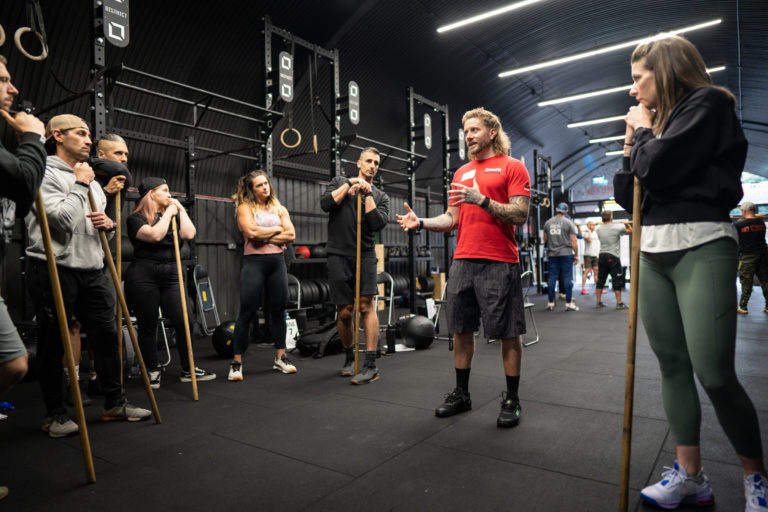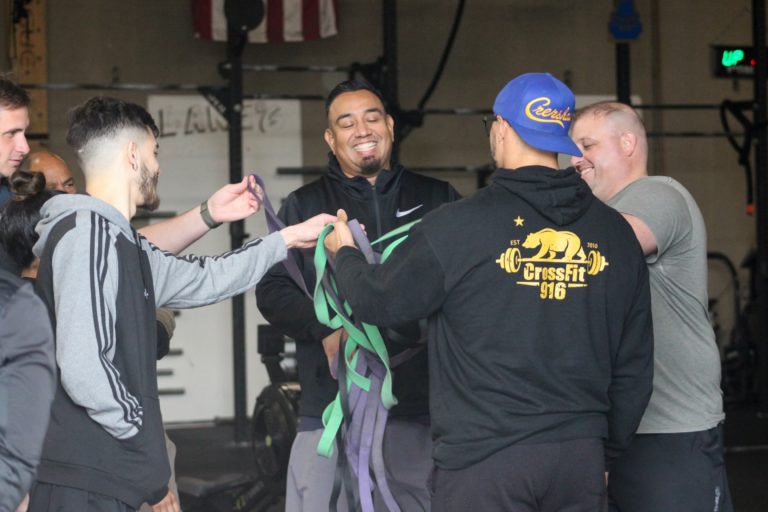Between the walls of CrossFit affiliates, we talk a lot about movement mechanics, and we also talk a lot about adequate nutrition to fuel your body. However, how often do we talk about social skills? In Matt Swift’s article “What Makes a Great Coach,” he outlines relationship building as a fundamental component of coaching. Within this category, he discusses that great coaches tend to have highly developed emotional intelligence; venerable coaches use empathy to connect with others. But what exactly does empathy look like in the context of a CrossFit affiliate? And how can we enhance our use and understanding of empathy to help those we coach?
Using examples from my experience as a trainer, I want to illustrate the importance of empathy and a few different ways it may be used at the affiliate. As you will notice in these scenarios, empathy was not employed as an excuse or a means to feel sorry for someone. Instead, by recognizing and acknowledging the fluctuating mentality of others, we can create a positive and uplifting experience for those we train. Enhancing empathy is worthwhile for any individual looking to lead and help others.
The Difference Between Perceiving and Sharing
 According to the Oxford English Dictionary, empathy is “the ability to imagine and understand the thoughts, perspective, and emotions of another person.” This does not mean we must share emotions or have experienced a similar situation to connect with someone. Instead, it is about the other person’s state of mind and our ability to recognize and comprehend that. As coaches, we should constantly seek to cultivate empathy toward those we coach to strengthen our relationships and improve the athlete training experience.
According to the Oxford English Dictionary, empathy is “the ability to imagine and understand the thoughts, perspective, and emotions of another person.” This does not mean we must share emotions or have experienced a similar situation to connect with someone. Instead, it is about the other person’s state of mind and our ability to recognize and comprehend that. As coaches, we should constantly seek to cultivate empathy toward those we coach to strengthen our relationships and improve the athlete training experience.
For example, early on in my experience as a CrossFit trainer, I led a class through a long workout on a Friday afternoon. At this point in my development as a trainer, I primarily focused on teaching movement and managing a group. Higher-level coaching was not on my radar because I was still working on the basics.
During the warm-up, I noticed one of my athletes wasn’t interacting with anyone and mostly looking down. I had coached this person before, and they were not particularly talkative, so the interacting piece did not worry me too much. I remember feeling self-conscious, wondering if I should acknowledge their behavior. I decided to say something but wanted to find the right moment.
Before transitioning into the specific warm-up, I asked the class to grab their equipment, and I went to this athlete and asked them, “Are you doing OK today?” I will never forget their response: they took a deep breath, noticeably trying to hold back from crying, and said, “No, but this is the only place I want to be, and I will explain everything to you later.” I gave the athlete a pat on the back, told them, “I got you,” and carried on with the class. Afterward, they told me a very sad story about a family member. They told me they just wanted to feel something “normal” by coming to class as they were still trying to process grief.
Every day, athletes bring their entire lives — joys, hardships, worries, goals, and countless stories — into our classes. While ideally, they’d share challenges beforehand, reality rarely follows the ideal. When an athlete seems off, a coach’s recognition of this can provide profound comfort. Though reading emotions isn’t always intuitive, I’ve learned the power of simply checking in when someone might need support. Knowing and genuinely caring about the people we coach transforms their training experience, carrying them through struggles and triumphs.
Key Point: Coaches must assess both physical and psychological readiness. Watch for shifts in mannerisms, interactions, facial expressions, and attitudes that deviate from an athlete’s baseline. When you spot these changes, don’t hesitate to check in.
Empathy Through Humor
 CrossFit pushes athletes beyond their comfort zones — lifting weights they never imagined possible, learning intimidating skills, and deciphering what seems like a foreign language. In these demanding moments, humor can be a powerful expression of empathy.
CrossFit pushes athletes beyond their comfort zones — lifting weights they never imagined possible, learning intimidating skills, and deciphering what seems like a foreign language. In these demanding moments, humor can be a powerful expression of empathy.
When my athletes struggle through front squats with a PVC pipe — a genuinely difficult movement even for experienced athletes — I might let them shake their legs while smiling and asking, “How much fun are we having right now?” Following with, “I know this stuff is hard, but you’re crushing it. Keep it up!” provides both acknowledgment and encouragement.
For newer athletes wrestling with unfamiliar skills or workout formats, sharing my own beginner stories — usually humorous ones — creates a connection through shared experience. This strategic blend of humor and empathy does more than just lighten the mood — it motivates athletes to persist through difficulty by showing you genuinely understand their struggle.
Key Point: We must remember how challenging new movements feel to our members. When you openly acknowledge the difficulty of what you’re asking athletes to do, you boost their morale and strengthen their resolve to continue.
Using Empathy to Challenge Athletes in Their Comfort Zones
 Consider the athlete with a competitive distance running background. When workouts involve longer runs or strategic pacing, they light up with that “this is my jam” confidence. As coaches, we can leverage this understanding to create meaningful challenges that push them beyond their strengths.
Consider the athlete with a competitive distance running background. When workouts involve longer runs or strategic pacing, they light up with that “this is my jam” confidence. As coaches, we can leverage this understanding to create meaningful challenges that push them beyond their strengths.
For these athletes, actual growth might come from removing their pacing advantage. For example, during Cindy, ask them not to look at the clock, forcing them to rely on feeling rather than strategy. During Jackie, challenge them to stay unbroken and grab the barbell within three seconds of finishing the row, disrupting their natural inclination to pace the workout methodically.
Empathy becomes a powerful tool for creating targeted challenges when you deeply understand what falls within or outside your athletes’ comfort zones. Rather than letting them cruise through familiar territory, you push them toward new dimensions of fitness by acknowledging their strengths and strategically removing these advantages.
Key Point: Consider providing personalized challenges for every athlete regardless of their experience level. This approach drives progress and demonstrates your commitment to guiding their development at every stage of their fitness journey.
Empathy is an incredible social skill that can be used to build and develop relationships. However, it should not be used to justify lowering the standard. In recognizing an athlete is having trouble reaching depth in a squat, you may empathize by providing a target like a medicine ball to squat to so the athlete can reach proper depth. You may elevate the set-up of a push-up to make the movement feasible for an athlete in a high-volume workout. It is essential, however, not to confuse empathy with sympathy. We do not scale athletes so they can breeze through workouts unchallenged. We are constantly assessing and making adjustments so we can “Set the Bar High” for our athletes. In return, we expect them to “Do It Right, Do It Well.” Great coaches can use empathy to empower others and elevate and enrich their experience within the affiliate.
 Emily Jenkins (CF-L3) is a head trainer and translator on the CrossFit Seminar Staff. She coaches out of her garage affiliate, CrossFit Iubhar, in Cantabria, Spain. Jenkins enjoys training her parents, and is always looking for a good read and a funny joke.
Emily Jenkins (CF-L3) is a head trainer and translator on the CrossFit Seminar Staff. She coaches out of her garage affiliate, CrossFit Iubhar, in Cantabria, Spain. Jenkins enjoys training her parents, and is always looking for a good read and a funny joke.